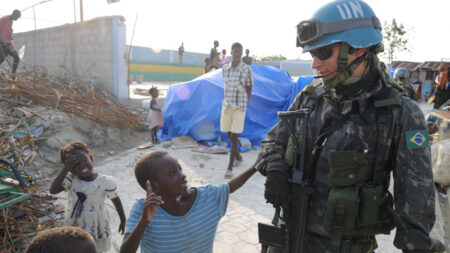A landslide caused by heavy rainfall claimed 17 lives in Congo on Sunday, with several other countries also reeling from climate change-induced floods.
Table of Contents
Overnight disaster
Following several days of torrential downpour, the Democratic Republic of Congo was rocked again with a landslide demolishing houses built along the Congo river in the northern city of Lisala in Mongala Province, according to Matthieu Mole, head of Forces Vives, a civil society organisation.
Witnesses saw houses built on the foot of nearby hills bear considerable damage from torrential rain, before a landslide reduced them to rubble, trapping residents inside. According to governor Cesar Limbaya Mbangisa, authorities were in desperate need of machinery to clear away debris in order to rescue survivors, while warning that the death toll could increase over time.
Three days of mourning have been declared by the governor in light of the incident which took the lives of seven women, seven men, and three children, all under five years of age. The local mortuary didn’t have space for the bodies, thus they were buried on the same day, according to Désiré Koyo, a Lisala official.
“Humanitarian crisis” in Congo and nearby countries
Prior to the recent incident, Congo was already reeling from devastating flash floods in the eastern part of the country that began on 8 May, claiming more than 400 lives, according to BBC. Landslides further complicated matters by rendering several main roads to affected areas impassable, thus restricting the flow of relief efforts. Those villages near the shores of Lake Kivu which were affected the most were deemed to be facing a “humanitarian crisis”, according to a spokesperson of Médecins Sans Frontières (MSF), who claimed that almost entire towns were swept away by the floods.

Devastation was of similar intensity on the other side of Lake Kivu, with Rwanda reporting at least 130 deaths from floods and landslides battering the northern and western provinces of the country. While the time period between March and May has usually brought heavy rainfall and subsequent destruction, floods this year have been more intense and lasting a longer duration. Rwanda hadn’t seen flooding this bad since 80 people died in the floods of May 2020.
Congo joins Libya as latest to be hit by floods
The news of devastation in Congo and its neighbouring countries adds to a distressing image of the world, with floods raging across nine nations currently, and four continents in just the first week of September. Merely a few days ago, the death toll of the “once-in-a-century” deluge in Libya crossed the 11,000 mark, with a further 30,000 displaced from their homes.
The suspect behind flooding in Libya has been identified as a Mediterranean storm named Daniel, which has also caused flooding in central Greece and northwestern Turkey. Brazil has been reeling from the worst cyclone disaster it has ever seen, while Typhoon Haikui submerged parts of Hong Kong and China. Central and coastal Spain and southwestern USA have also been struggling with flooding.

Lack of consensus whether climate change behind
Authorities and experts have been swift in attributing the proliferation of devastating floods across the planet to climate change, with several studies establishing a link between global warming and extreme weather events. However, determining climate change as having a direct causal effect on flooding is far from a straightforward affair.
While scientists don’t agree whether climate change is directly behind floods, it is clear that climate change does impact the factors that are responsible for flooding, like more rainfall. As noted by a recent study in the Nature journal, the spike in global temperatures has a visible link with an uptick in precipitation intensity since 2002.
A warmer climate will speed up evaporation from land, oceans and water bodies, leading to the atmosphere holding more moisture. According to experts, a rise of 1 degree celsius directly translates to 7% more moisture, making storms more intense, frequent and long lasting, meaning floods hit harder than before.

This has, in turn, created a puzzling scenario; the world is getting drier and wetter, all at the same time. According to a report by Grist magazine, higher temperatures rob the soil from its moisture, making droughts even worse. Simultaneously, a warmer atmosphere holds more of that moisture and dumps it in an already wet area, thus making floods worse.
Another factor could be rising sea levels. Higher temperatures caused by climate change have been observed to be fueling the rate at which glaciers and ice sheets have been melting, which in turn adds to global sea levels and leaves coastal areas at the peril of flooding. A 2022 NOAA Climate report suggested that since 1880, the global mean sea level has gained around 21-24 centimetres.
With a backdrop of much higher water levels, devastating weather events, similar in intensity to Hurricane Katrina, Hurricane Michael and “Superstorm” Sandy, meander closer to the heart of a nation and away from the sea than before. High-tide flooding, or “nuisance flooding” is another concern, which is far less destructive in power, but is still capable of disrupting daily life and racking up financial losses.

Studies that endeavour to establish a more direct link between climate change and flooding have been hindered by the little information we have on past floods, especially those of the catastrophic nature which seldom occur. Moreover, pointing the finger solely at climate change does disservice to other known factors like weather patterns of the affected area, soil characteristics, local topography, etc.
Daniel Swain, climate scientist at the University of California, Los Angeles, articulated on similar struggles in connecting climate change to tornadoes. “Floods fall somewhere along the confidence spectrum between heat waves (“yes, clearly”) and tornadoes (“we don’t know yet”),” he said.













